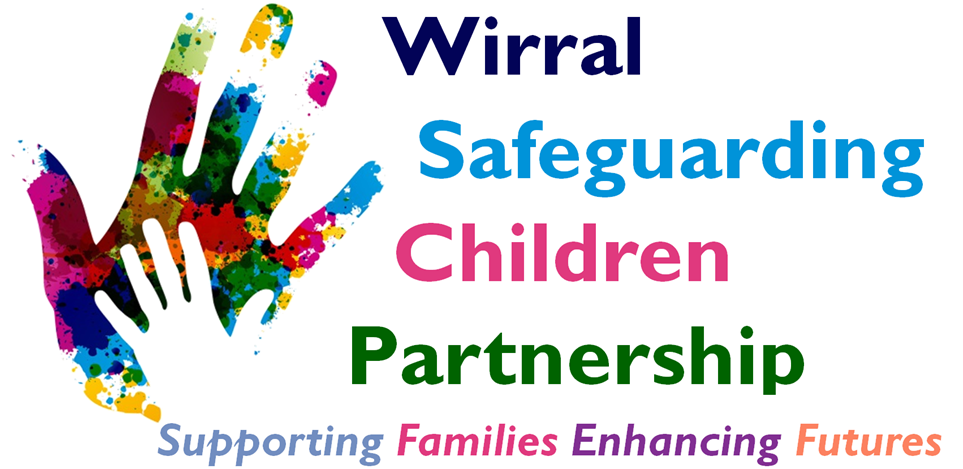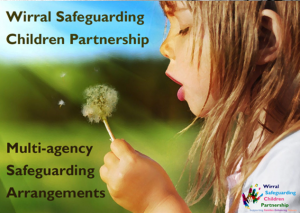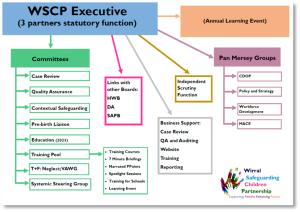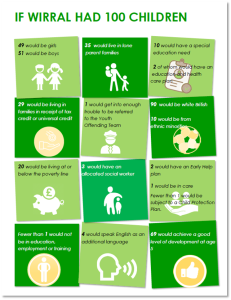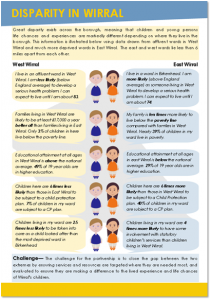Annual Report 2022 – Background

In this section:
- Role of the WSCP
- Structure of the WSCP
- Summary of Activity
- Welcome to Wirral
- If Wirral had 100 children
Role of the Wirral Safeguarding Children Partnership (WSCP)
The local multi-agency safeguarding system in Wirral is led by the Wirral Safeguarding Children Partnership (WSCP). Safeguarding children partnerships are statutory multi-agency bodies established under the Children Act (2004) as amended by the Children and Social Work Act (2017). Partnerships are responsible for establishing and ensuring the effectiveness of local arrangements to safeguard and promote the welfare of children. The arrangements are led by three statutory safeguarding partners (the Local Authority, Merseyside Police, and Wirral Clinical Commissioning Group (Integrated Care Board since July 2022)). The partners must establish a local model for safeguarding and determine how they work with other relevant agencies to keep children safe.
The local safeguarding system must ensure:
• children are safeguarded and their welfare promoted
• partner organisations and agencies collaborate, share and co-own the vision for how to achieve improved outcomes for vulnerable children
• organisations and agencies challenge appropriately and hold one another to account effectively
• there is early identification and analysis of new safeguarding issues and emerging threats
• learning is promoted and embedded in a way that local services for children and families can become more reflective and implement changes to practice
• information is shared effectively to facilitate more accurate and timely decision making for children and families
The WSCP’s safeguarding arrangements are set out in detail in this document:
The partnership is responsible for ensuring the effectiveness of our local safeguarding arrangements and the annual report aims to provide a rigorous and transparent assessment of the performance and effectiveness of local services. It also aims to identify areas of weakness; the causes of those weaknesses and actions being taken to ensure improvements. The report also includes an account of progress made in implementing actions from reviews, lessons and the sharing of learning. Finally, the report sets out the refreshed partnership priorities for 2023-24 in our business plan.
Structure of the WSCP
The WSCP has a committee structure sitting underneath an executive group led by the three statutory partners. All of the committees and task groups have multi-agency membership drawn from across the partnership and are chaired by a senior colleague from a partner agency. The WSCP’s structure includes a Case Review committee who lead and maintain oversight of the statutory case review function.
A number of safeguarding children activities are completed on a pan-Merseyside footprint, and these include the child death function, oversight of policies and strategies, workforce development and a strategic multi-agency child exploitation group.
Members of the WSCP executive also sit on a variety of other statutory and influential boards and bodies including the health and wellbeing board, the domestic abuse alliance, the safer wirral partnership and the safeguarding adults partnership board.
A structure diagram for the WSCP is presented below:
Executive and committee led work is illustrated in several pages on the WSCP website where you can find out more about our activity:
WSCP Executive –
Membership: Local Authority children’s services, health economy (CCG, ICB), Merseyside Police
Partner Attendance:
- Wirral Local Authority – 100%
- Health Economy (CCG, ICB) – 100%
- Merseyside Police – 84%
Examples of Activity:
- wirralsafeguarding/thepartnership
- wirralsafeguarding/independentscrutiny
- wirralsafeguarding/learningevents
WSCP Case Review Committee –
Membership: Health Economy (CCG, ICB), Children’s Social Care, Practice Improvement Team, Merseyside Police, Primary Education, Early Childhood Services, WSCP
Examples of Activity:
WSCP Quality Assurance Committee –
Membership: Children’s Social Care, Early Help and Prevention, Early Childhood Services, Youth Justice Service, Attendance Service, NHS Foundation Health Trusts (Wirral Community Health and Care; Wirral University Teaching Hospital; Cheshire and Wirral Partnership), Education Sector, CCG/ICB, Merseyside Police, Merseyside Probation, Merseyside Fire and Rescue Service, WSCP Lay Member, WSCP
Examples of Activity:
WSCP Contextual Safeguarding Committee –
Membership: Children’s Social Care, Early Help and Prevention, Youth Justice Service, Youth Service, NHS Foundation Health Trusts (Wirral Community Health and Care; Wirral University Teaching Hospital; Cheshire and Wirral Partnership), CCG/ICB, Compass Team, Catch22, Contextual Safeguarding Service, Merseyside Police, LA Licensing, Safeguarding Adults Partnership Board, Education Sector, WSCP Lay Member, WSCP
Examples of Activity:
WSCP Training Committee –
Membership: Children’s Social Care, Safeguarding Unit, Early Help and Prevention, Wirral Council Organisational Development, Forum Housing, Catch22, Contextual Safeguarding Service, Health Economy representatives, Domestic Abuse Hub, Voluntary and Community representatives, WSCP Training Officer
Examples of Activity:
WSCP Education Committee (new for 2023) –
Membership: To be confirmed
Examples of Activity:
WSCP Child Death Overview Panel (Pan-Merseyside) –
Membership: Independent Chair, CDOP Manager, Health Economy representatives (including designated professionals, consultant staff, operational managers), Children’s Social Care Representatives, Safeguarding Partnership Representatives, Public Health, North West Ambulance Service, Merseyside Police, Lay Member, Education Representatives, Legal Adviser
Examples of Activity:
WSCP Neglect Task and Finish Group –
Membership: CCG/ICB, Children’s Social Care, Early Help and Prevention, Youth Justice Service, Merseyside Police, AgeUK, Adults Social Care, Safeguarding Adults Partnership Board, WSCP
Examples of Activity:
WSCP VAWG Task and Finish Group –
Membership: Domestic Abuse Hub, Merseyside Police, Children’s Social Care, WSCP
Examples of Activity:
WSCP Systemic Practice Steering Group –
Membership: Children’s Social Care, Practice Improvement Team, Systemic Practice Lead, Early Help and Prevention, Youth Justice Service, Merseyside Police, Health Economy Representatives, WSCP
Examples of Activity:
Summary of Activity
2022 was a year full of activity for the WSCP. The year began with the partnership agreeing to develop our Supporting Families Enhancing Futures (SFEF) approach for working with children, young people and families into a systemic practice model centred on building strong and purposeful relationships.
During the year we developed our model and partnered with Warrington Council – who have proven expertise in the field of systemic practice – to develop a comprehensive programme of training for professionals. We were able to begin delivering training and briefings in the autumn and these will run through 2023 and beyond.
A priority area for 2022 was the development of a local strategy for tackling violence against women and girls (VAWG). The tragic deaths of Sarah Everard and Sabine Nessa in 2021 shocked the country and shone a light on the experiences of many women and girls who are afraid to be out, especially by themselves for fear of being attacked. The combination of these killings, and reported experiences at a time when statistics show that rates of domestic abuse and the number of women requesting support following the COVID-19 pandemic has surged, has led to widespread calls for change.
The WSCP has led the development of a strategy with four key priority areas of prevention and education; support for victims; reducing harm; and building safer communities. The strategy was successfully launched in December 2022.
Work has continued on the breaking the cycle programmes which have been running throughout 2022. The programmes are designed to target support at families who suffer from multiple deprivation. In 2023 the WSCP will begin to evaluate the inpact of the programmes, but feedback from families and professionals so far indicates that the programmes are making a very real difference to families.
Tackling neglect is a priority area for the WSCP, and its impact has been, and continues to be highlighted in audits and local learning reviews undertaken by the partnership. In 2022 the WSCP established a multi-agency working group to develop a new Wirral wide neglect strategy. The working group includes agencies from the safeguarding adults partnership to ensure the strategy covers all citizens in Wirral.
Consultation will begin on the strategy early in the new year ahead of its launch in the spring.
Undertaking Child Safeguarding Practice Reviews (CSPR’s) for cases where a child has died or been seriously harmed, and abuse or neglect is known or suspected, is a statutory responsibility of the WSCP. During 2022 the WSCP undertook two CSPR’s, one in respect of a two year old who tragically passed away at home. The family had had significant involvement with services over the years.en he was found in his bed unresponsive. A second CSPR is also underway in respect of a 9 week old baby who was seriously injured in a co-sleeping incident, and tragically later passed away.
More detail, and learning from both cases is set out in the Activity chapter.
The WSCP undertakes two types of audits throughout the year. The Section 11/175 safeguarding compliance audit tests how well organisations, including all schools are meeting their statutory safeguarding responsibilities. A summary of the findings for 2022 is presented in this report. The WSCP also undertakes a series of deep dive thematic multi-agency audits. These attempt to ‘shine a light’ on the quality of practice by focusing on a small number of cases. In 2022 the WSCP completed audits on the themes of neglect, parental substance misuse, adverse childhood experiences, and an evaluation of the introduction of the ICON programme.
In May 2022 the government published its independent review of children’s social care. The review was independently chaired by The review was independently led by Josh MacAlister, and made a series of recommendations about how social care – and early help services should be configured and provided to children and families in need.
The WSCP has considered the recommendations, many of which are aligned to the way we are developing our own services – for example ensuring services have a community focus and are accessible to families living in neighbourhoods across the borough, and will ensure that future plans published by the government are incorporated into our work.
In December Wirral was subject to a Joint Targeted Area Inspection (JTAI) with a focus on families who require Early Help services. JTAI’s are led by Ofsted but also include the Care Quality Commission (CQC), and His Majesty’s Inspectorate of Constabulary (HMICFRS), who have a focus on the health economy and police respectively as part of the inspection. The WSCP will receive a letter of findings about the inspection in February and will publish it on our website.
Further information about the activity undertaken by the WSCP in 2022, including our statutory case review activity is detailed in the Activity chapter here.
Welcome to Wirral
Wirral is a large metropolitan area covering the northern 60 square miles of the peninsula between the Dee and Mersey Estuaries. Wirral is well known for the high quality of its countryside and coast, and transport links to Liverpool, Chester and North Wales.
The borough is less well known as an area of strong contrasts. The predominantly built-up eastern area opposite Liverpool, forms part of the core of the Merseyside conurbation. Almost two-thirds of the population live within the urban area to the east of the M53 motorway, between the coastal resort of New Brighton in the north, to the entrance of the Manchester Ship Canal in the south. Birkenhead, located at the heart of east Wirral, is the largest town within the area, historically built around the maritime trades associated with the Mersey docklands, which have steadily declined since the 1960’s. The majority of statutory work for partner agencies is with families from the ‘dockland’ areas of Wallasey and Birkenhead.
The population of Wirral is 322,796 (ONS, 2018) with an economically active population of 155,300 (ONS 2018). The proportion of people of working age, particularly of younger adults, is at its highest in central and inner areas of east Wirral. The proportion of older age groups is generally larger in the west. The population is predominantly white British (90%) but significant ethnic minority groups exists, particularly Irish, Chinese and Polish.
There are approximately 67,508 children (0 to 17 years) living in the borough. Of the total population, this equates to 21% of the population being aged under 18. Of all children, 17.4 % live in poverty (Wirral Compendium of Statistics, 2021). The current rate of Children Looked After is 120 per 10,000 with 567 children in Foster Care.
In the latest Index of Multiple Deprivation, Wirral was ranked 77th most deprived authority out of 326. Although Wirral’s overall ranking for deprivation has gone down between 2015 and 2019, the number of LSOAs in the most deprived 20% of areas in England has increased by 10. This means that an additional 20,000 residents are now classed as living in deprivation compared to 2015 (IMD 2019).
Following a very encouraging recent Joint Targeted Area Inspection, the WSCP is looking forward to building on the strength of the partnership as all agencies work together to safeguard our children.
If Wirral had 100 Children
The graphic below illustrates some key statistics for children and young people in Wirral. Below it is a graphic first published in last years report, but still very relevant, which exemplifies the disparity that exists between local areas in Wirral. Narrowing the disparity gap remains a challenge for all agencies, and is something currently being addressed by the ‘breaking the cycle’ progamme of strategies in Birkenhead.
Disparity Between the Most and Least Affluent Wards
The latest Office for National Statistics data about income deprivation (December 2022) reveals that Wirral is the 38th most income deprived LA area (out of 316). And, of the 206 neighborhoods in Wirral, 65 were among the 20 per cent most income-deprived in England. However, 27 neighbourhoods were in the 20 per cent least income-deprived in England, highlighted the disparity which exists across the borough.
In the least deprived neighbourhood on Wirral, 1.4% of people are estimated to be income-deprived. In the most deprived neighbourhood, 58.1% of people are estimated to be income-deprived. The difference between those two neighbourhoods is 56.7% and that is the internal disparity figure. Wirral has one of the widest internal disparity figures in the country, and closing this disparity gap remains a challenge for all partners.
To go to the Introduction page click here
To go to the Journey of the Child page click here
To go to the Key Activity page click here
To go to the Multi-agency Working page click here
To go to the Business Plan page click here
To go to the Glossary click here
To return to the Annual Report Home Page click here.
